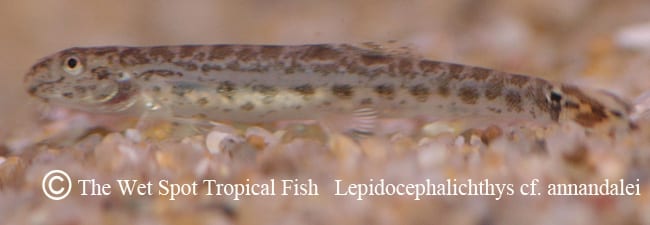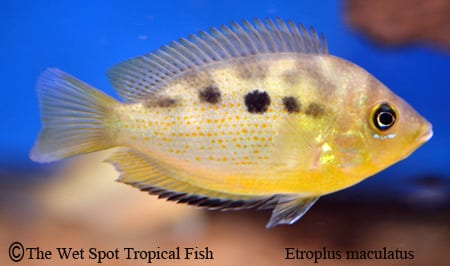It’s a Wet Spot Fishmas Special!
It’s a Wet Spot Fishmas Special!
Well, it’s the eve of the one of the most celebrated holidays in America, and while we recognize not all of our amazing customers participate in decking their halls, we maintain Fishmas as the non-denominational holiday all fish-lovers can get down with. Without further ado, let’s don our tanks in gay apparel with some of our most extravagantly colorful and patterned aquatic friends. Hark! the herald aquarists sing, glory to: Microphis deocata, Lepidocephalichthys cf. annandalei, and Etroplus maculatus.
Scientific NameMicrophis deocata
Common NameIndian Royal Green Pipefish
Temperature / pH72 to 76°F / 6.0 to 7.5 pH
Native LocationIndia/Bangladesh
Preferred DietSmall invertebrates
On the first day of fishmas my true love gave to me, an M. deocata in a… river stream biotope tank. Known more commonly as “Indian Royal Green Pipefish”, these gorgeous cousins of seahorses are distributed throughout India and Bangladesh. Reaching 6 inches in length, these pipefish and long and skinny with green bodies. Just as with seahorses, males are the sex that carry the young in a brood pouch under their tails, and females must court and impress their potential mates. Females, thus exhibit, beautiful red and blue striped sails on their undersides. Found in rivers, streams, and lakes among aquatic plants, they do best in setups with soft substrate, dense vegetation, plenty of hiding places, and floating plants to diffuse light. Peaceful, but shy and slow competitors, they should only be kept with other slow, small, and peaceful species. Micro-predators by nature, they will only accept small, live foods in captivity, and require a healthy supply of baby brine. Tank waters should be maintained with temperatures between 72 and 76°F, pH of 6.0 to 7.5, and hardness around 53 to 178 ppm.
Scientific NameLepidocephalichthys cf. annandalei
Common NamePeacock Loach
Temperature / pH72 to 78°F / 6.0 to 7.5 pH
Native LocationGanges and Brahmaputra
Preferred DietSinking foods
A symbol of eternal life and resurrection in Christian culture, what’s more Christmasy than a peacock? How about a “Peacock Loach”? L. cf. annandaleiis a gorgeous loach that reaches just under 2 inches in length, and gains it’s common name from the feather-like spot on their caudal fin. Found in the Ganges and Brahmaputra river systems,these loaches prefer shallow, slow-moving stretches of streams and calm swamps and backwaters. In captivity they require soft, sandy substrate they may bury themselves in, dense vegetation, driftwood roots and branches, water-worn rocks, and dried leaf litter. Generally peaceful and gregarious, they do best in groups of around 4, and can be kept alongside small, peaceful fish from their region. Substrate sifters, Peacock Loaches consume small invertebrates from the sand, and should be fed primarily small live and frozen invertebrates, though they will accept sinking dried foods. Tank waters should be kept with temperatures of 72 to 78°F, pH between 6.0 and 7.5, and hardness of 36 to 268 ppm.
Scientific NameEtroplus maculatus
Common NameOrange Chromide
Temperature / pH70 to 80°F / 7.0 to 8.5 pH
Native LocationIndia and Sri Lanka
Preferred DietOmnivorous
As golden as the star of Bethlehem, E. maculatus is a popular ornamental species in the aquarium trade. Found in India and Sri Lanka, “Orange Chromides” inhabit brackish estuaries and coastal lagoons. In captivity, they can be kept with brackish or freshwater conditions. Decor and tank setup is largely left to aquarist’s choice, though they do best with sandy substrate and some degree of structure that simulates their natural environment like rocks and branches. Reaching just over 3 inches in length, these chromides have ovular and vertically flat bodies with bright, golden orange coloration, and a dark side spot. Peaceful unless breeding, they are best kept with ‘dither’ fishes like salt-tolerant cyprinids (Danio, Rasbora, etc.), and should be kept in larger conspecific groups to moderate breeding aggression and territoriality. Wild specimens consume mostly aufwuchs and filamentous algae, but these fish are considered generalists. In captivity they should be fed balanced diets consisting of small live and frozen invertebrates, spirulina, algae, and other vegetable matter. Orange Chromides do best in tank waters with temperatures around 70 to 80°F, pH of 7.0 to 8.5 (intolerant to acidic conditions!), and hardness between 179 and 357 ppm.
Whether there’s a tree stocked with presents or a mantel adorned with stockings in your home or not, now is the time to invoke the spirit of Fishmas. Treat yourself, and your tanks to some special ornamentation.


